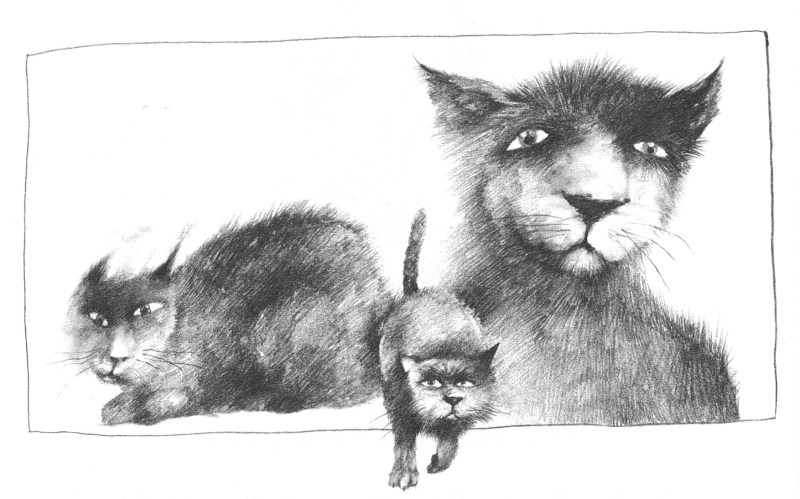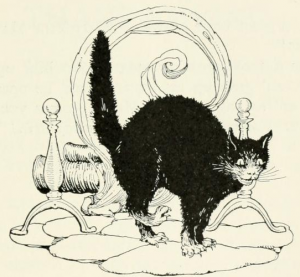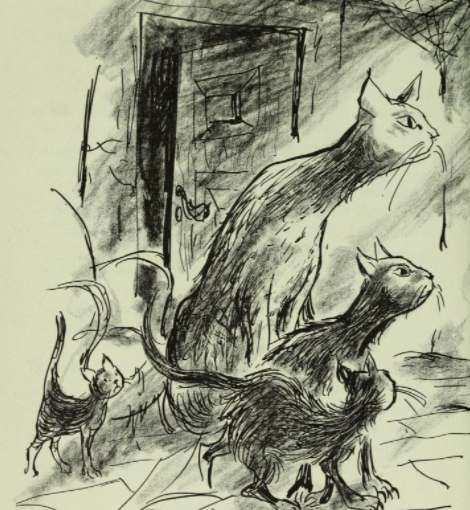Back in 2011 I wrote about my history with and love for the Scary Stories to Tell in the Dark series. One thing I’ve enjoyed about the stories I read in my childhood is encountering their origins or earlier versions through the years. Now, as part of my never-ending quest on this site to start new things that I rarely revisit or see through satisfactorily, I’m going to start a series of posts focused on the light history and evolution of some classic scary stories. Starting with the joke story, “Wait ’til Martin Comes.”
As it appears in the first volume of Scary Stories, it is the tale of a man who seeks shelter from a storm in an old house. He falls asleep in the house three times. The first time he wakes up, an ordinary black cat has joined him. The second time, the first cat is now accompanied by another cat that is “as big as a wolf.” The cats speak to each other.
“Shall we do it now?” the larger cat says.
“Let’s wait till Martin comes,” the other says.
The man tells himself he’s dreaming and falls asleep one more time. When he wakes up, a black cat the size of a tiger is present and it asks the other two, “Shall we do it now?” They agree to, “Wait till Martin comes.”
Understandably not wanting to find out how big Martin is or what the cats plan to do, the man says, “When Martin comes, you tell him I couldn’t wait,” then runs out into the storm.
The same story appears in 1959’s The Thing at the Foot of the Bed, and Other Scary Tales by Maria Leach. Even details such as seeking shelter from a storm appear in Leach’s telling, which is worth pointing out because, as we’ll see, older versions of “Wait ‘Til Martin Comes” didn’t follow the exact same course.
The story is basically a joke derived from a “traditional Negro folk tale,” per the “Sources” section Alvin Schwartz provides at the end of his book. He then gives four different sources that all tell slightly altered versions of the story. The oldest version Schwartz cites comes from Newbell Niles Puckett’s Folk Beliefs of the Southern Negro, published in 1926. In it, the man just agrees to stay in a haunted house, as opposed to seeking shelter from the storm. The first cat that appears says, “Well, I can’t do nothin’ ’til Martin comes,” then vanishes. The bigger cat comes in, says the same, and also vanishes. When the third, tiger-sized cat repeats the routine, the man in the house does his own more practical and self-preserving disappearing act to keep from seeing Martin in the flesh.
Two versions appeared in The Journal of American Folklore, one in Volume 40 (1928), the other in Volume 47 (1934). In both of these the name “Martin” is replaced; by “Patience” in the 1928 version and by “Emmett” in the second one.1 In both stories the man in the house is stated to be a Bible-packing preacher. The 1928 version is very brief and to the point, while the 1934 retelling stretches things out considerably, with each cat playing around in red-hot fireplace coals before saying their line, but both follow the same general plot and reach the same destination. Increasingly large cats, implied threats, and then our protagonist books it before the titular (and presumably biggest) cat arrives.

Before looking at some other retellings, a couple of things to note here:
- Schwartz and Leach had the grace not to write the story in affected “Negro dialect” which dominates the other versions of this tale mentioned thus far (as well as a couple more to come).
- Related to that, one thing I like about the “original” story, as compared to some other “Negro folktales” involving ghosts, is that it’s not about a black person being afraid of their own shadow, or mistaking an innocent animal for a spirit. There are plenty of examples of other stories like that available just in the volumes I’ve mentioned, as well as elsewhere. In this story, though, our protagonist is faced with something bizarre and unsettling that would scare just about anyone, and when he gets the hell out of dodge it’s obviously the smart thing to do, not a cowardly act.
- The stories with “Patience” and “Emmett” in The Journal of American Folklore make it clear that these aren’t otherworldly cats of undefined nature, but ghosts taking on the form of cats. Puckett’s story implies this by stating that it’s a haunted house, but the Folklore stories make it plain.
In 1944, Benjamin Botkin wrote A Treasury of American Folklore which has a significant deviation from the earlier stories. In his telling, four ghosts visit the preacher, each one taking on a different bizarre form. The first is in the form of a man who’s shifting between missing parts of himself–he’s initially headless, then just a head with no body, then a body with no arms. The next ghost is a mule that also goes from headless to body-less. Then comes the “biggest cat anybody ever seen,” before, finally, a large dog with some boar-like features arrives. Each ghost mentions another that is yet to come named “Whalem-Balem.” Like (almost) always, the protagonist bolts before that last ghost arrives.
Pre-dating all of these, and not cited by Alvin Schwartz, is the earliest form of this story in print (to my knowledge). Published in 1921’s Happy Holidays, Frances G. Wickes’ version has some significant differences from the better known version. To begin with, the cats don’t just “imply” a threat. Each says of the preacher, “Shall I bite him now?” speaking to something unseen, which answers, “Wait till Martin comes.” The three cats don’t increase in size, either, although each is a different color; the first is yellow, the second gray, the last black. As mentioned before, there is another presence in the house, “a great voice” belonging to something that never appears, but that presumably isn’t Martin (unless Martin likes to speak in the third person).

As far as scariness goes, I find the differences between the Wickes version (and others that follow the Wickes story more closely) and the Schwartz one a mixed bag. I find the idea of the cats increasing in size and saying, “Shall we do it now?” more chilling than directly threatening to bite someone, even in a story that’s just a joke. I also enjoy the cats being more vaguely preternatural occupants of an unexpectedly strange old house, rather than explicitly inhabiting a haunted house and being shape-shifting ghosts. On the other hand, the “great voice” from Wickes story is pretty interesting. That’s an extra touch that makes the story about as scary as it can be, given that the story always ends with the punchline of the protagonist making an early exit before Martin can arrive.
Except…
I did find one retelling of this story that doesn’t go for the punchline ending. In 1973, Troll Records released the album, Scary Spooky Stories, a collection of audio fiction for kids. It’s not above telling jokey ghost stories as it contains the purely humorous tale “Big ‘Fraid, Little ‘Fraid.” Immediately after that story, though, actor Ralph Bell recounts the story of a man who evades a cat in the road but wrecks his car in the process. So, this being a stormy night, he finds shelter in a “very big, very old, very-falling-apart house.” You can surely guess what happens from here, but if you’re familiar with the story, you might not be prepared for what happens at the end.
In this case, our protagonist waited just a little too long.

